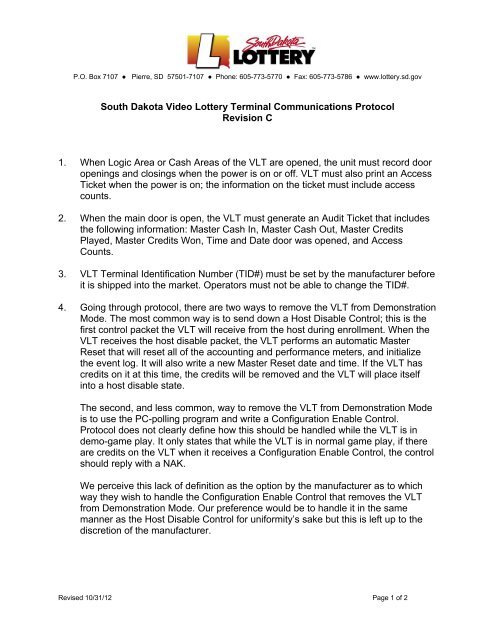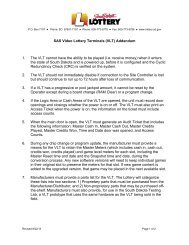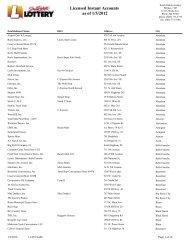Video Lottery Terminal Communications Protocol Addendum
Video Lottery Terminal Communications Protocol Addendum
Video Lottery Terminal Communications Protocol Addendum
Create successful ePaper yourself
Turn your PDF publications into a flip-book with our unique Google optimized e-Paper software.
P.O. Box 7107 ● Pierre, SD 57501-7107 ● Phone: 605-773-5770 ● Fax: 605-773-5786 ● www.lottery.sd.gov<br />
South Dakota <strong>Video</strong> <strong>Lottery</strong> <strong>Terminal</strong> <strong>Communications</strong> <strong>Protocol</strong><br />
Revision C<br />
1. When Logic Area or Cash Areas of the VLT are opened, the unit must record door<br />
openings and closings when the power is on or off. VLT must also print an Access<br />
Ticket when the power is on; the information on the ticket must include access<br />
counts.<br />
2. When the main door is open, the VLT must generate an Audit Ticket that includes<br />
the following information: Master Cash In, Master Cash Out, Master Credits<br />
Played, Master Credits Won, Time and Date door was opened, and Access<br />
Counts.<br />
3. VLT <strong>Terminal</strong> Identification Number (TID#) must be set by the manufacturer before<br />
it is shipped into the market. Operators must not be able to change the TID#.<br />
4. Going through protocol, there are two ways to remove the VLT from Demonstration<br />
Mode. The most common way is to send down a Host Disable Control; this is the<br />
first control packet the VLT will receive from the host during enrollment. When the<br />
VLT receives the host disable packet, the VLT performs an automatic Master<br />
Reset that will reset all of the accounting and performance meters, and initialize<br />
the event log. It will also write a new Master Reset date and time. If the VLT has<br />
credits on it at this time, the credits will be removed and the VLT will place itself<br />
into a host disable state.<br />
The second, and less common, way to remove the VLT from Demonstration Mode<br />
is to use the PC-polling program and write a Configuration Enable Control.<br />
<strong>Protocol</strong> does not clearly define how this should be handled while the VLT is in<br />
demo-game play. It only states that while the VLT is in normal game play, if there<br />
are credits on the VLT when it receives a Configuration Enable Control, the control<br />
should reply with a NAK.<br />
We perceive this lack of definition as the option by the manufacturer as to which<br />
way they wish to handle the Configuration Enable Control that removes the VLT<br />
from Demonstration Mode. Our preference would be to handle it in the same<br />
manner as the Host Disable Control for uniformity’s sake but this is left up to the<br />
discretion of the manufacturer.<br />
Revised 10/31/12 Page 1 of 2
5. During any chip change or program update, the manufacturer must provide a<br />
means for the VLT to retain the Master Meters, including the Master Reset time<br />
and date and the Snapshot time and date, during the conversion process so the<br />
<strong>Lottery</strong> is not forced to do a reconciliation on each VLT being converted.<br />
6. Manufacturers must provide a parts list for the VLT. The <strong>Lottery</strong> will categorize<br />
these lists into two sections: 1) Proprietary parts that must be purchased from the<br />
Manufacturer/Distributor; and 2) Non-proprietary parts that may be purchased offthe-shelf.<br />
Manufacturers must also provide, for use in the South Dakota Testing<br />
Lab, a VLT prototype that uses the same hardware as the VLT being sold in the<br />
field.<br />
7. In the event of a shutdown while a VLT is being played, “polite shutdowns” which<br />
utilize a countdown before the VLT forces the cash-out are allowed and<br />
preferred, though not mandated. No rule currently exists requiring that a cashout<br />
be forced; it is at the discretion of the manufacturer to let the VLT stay active<br />
until all credits are played down to a zero balance or the player decides to cash<br />
out.<br />
8. If a VLT is shut down during play, a message must be sent that indicates the game<br />
itself is being closed down. To avoid confusion by players as to whether the<br />
establishment itself or the <strong>Lottery</strong> is closing down, appropriate messages should<br />
be utilized such as “Game is Closing” or “This VLT is Closing.”<br />
9. A VLT may NOT be disabled while the player is in the middle of a game. The<br />
player must finish the hand or bonus round before even a polite shutdown can<br />
begin. The credits on the VLT must be played off or a cash-out forced before the<br />
machine can be disabled.<br />
10. State law requires that pay tickets generated by a VLT contain a serial number.<br />
11. One version of <strong>Protocol</strong> documentation says the <strong>Protocol</strong> version in South Dakota<br />
is hex 12. This is a typo; South Dakota <strong>Protocol</strong> version is OC.<br />
A Division of the South Dakota Department of Revenue Page 2 of 2
















